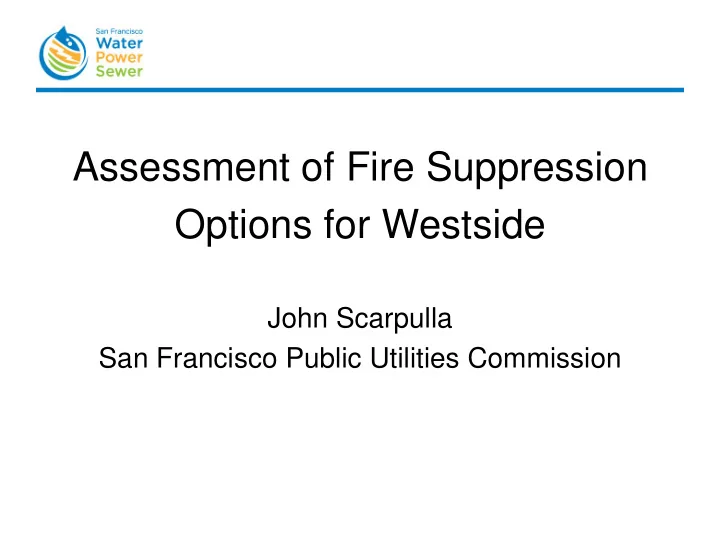

Assessment of Fire Suppression Options for Westside John Scarpulla San Francisco Public Utilities Commission
Partnership • Since 2010 - SFPUC, SFFD, and Public Works have been implementing projects to improve the AWSS. • SFFD is the end user: System improvements and expansion must meet SFFD quality standards . • SFPUC employs the City’s experts in the design, construction, operation & maintenance of water systems. • SF Public Works provides project management expertise and guidance. • Hydraulic Modeling utilized to guide decision making. 2
Reliability in 2010 3
Achievements – Capital Projects 4
Achievements – Maintenance 5
Work in Progress • Connecting the 70 million gallon South Basin of the University Mound Reservoir to AWSS; • 16 pipeline and tunnel projects; • Continued motorizing of valves for remote control, and improvement of their electronic control system; • Structural and seismic upgrades of Seawater pump station #2; and • Design of pump station at Lake Merced. 6
GAO Committee Request March 2017 - Government and Audit Oversight Committee request: 1. Report analyzing options for Westside : a) AECOM Contracted to analyze 12 options: i. Expansion of AWSS – 7 options ii. Installation of a Potable AWSS – 5 options b) Collaborative review of report by SFPUC & SFFD c) Final recommendation by Chief and General Manager 2. Independent Review by 3rd party expert a) Professor Charles Scawthorn to perform review 7
Potable AWSS • Designed to meet the robust performance standards required by SFFD to fight large fires. • Utilizes the same earthquake resistant pipes, seismically- reliable valves, hydrants, and components utilized by the AWSS. • In addition, system rated to meet drinking water standards: • During non-fires, minimal connections to low-pressure water system by seismically reliable valves. • If fire occurs, valves are closed and the pressure of the system is increased via redundant pumps. • Main Ancillary Benefit: After firefighting following an earthquake, system is able to provide drinking water to the Sunset and Richmond Districts even if the City’s low -pressure drinking water distribution system incurs numerous breaks and leaks. 8
Criteria for Analysis • Options 1-7: Expansion of AWSS • Options 8-12: Potable AWSS • Criteria for Analysis : • Modeled and analyzed for hydraulic performance fighting fires after a 7.8 earthquake. • Reliability of water supplies • Design of piping network • Impacts to other areas served by AWSS • Ancillary benefits • Cost 9
Analysis of AWSS Options • Modeling results show there is not enough supply and pressure in the current AWSS to effectively serve the Richmond District. • Piping network can be configured to increase pressure in Richmond District, but it reduces pressures to below performance levels in other areas of City. • There is not enough pressure to reach the Sunset District. • Need to add supplies from Sunset Reservoir or Lake Merced. • For about the same cost of an AWSS for Richmond District only, both the Richmond and Sunset districts can be served using a Potable AWSS network. 10
Analysis of Supply of Potable AWSS • Sunset Reservoir is the supply for Potable AWSS: • Connects to the seismically reinforced North Basin of Sunset Reservoir • The North Basin contains 90 million gallons of water, and is isolated from the South Basin. • The reservoir is constantly being replenished by the seismically strengthened Hetch Hetchy system, and will receive water within 24 hours of a big earthquake. • To empty the reservoir, ALL of the fire department’s engines pumping at maximum capacity for 24 hours, with no refill from Hetchy System: SFFD Confirmed they would never have all engines pumping from this reservoir. Hetchy will refill it within 24 hours. 11
Potable AWSS Piping Analysis • Potable AWSS options 8-10: • Lack redundancy in their pipe networks. • Potable AWSS options 11-12: • Inherently greater reliability due to redundant looped pipe networks. • Meet the performance requirements of SFFD and SFPUC. • Do not negatively impact performance of existing AWSS. • Can be designed to assure post-earthquake reliability comparable to the existing AWSS reliability. 12
Option 11 13
Option 12 14
SFPUC & SFFD Recommendation • SFPUC and SFFD Mgmt. recommend Option 12 • Perform detailed design and analysis to ensure performance requirements of SFFD are met. • Design for agility and the flexibility to add new technologies and water sources to the system in the future. • Design to allow the piping network to be extended in the future to serve additional areas. 15
Reliability Scores – ESER Bond Projects & Option 12 16
Cost of Preferred Option Total Estimated Cost: $109 Million Available Funding from $40 million SFPUC Operating Budget: ($10 million/year for 4 years) Total amount of Bond $69 million Funding Needed: Use SFPUC funds to begin work ASAP. 17
Professor Scawthorn Findings • Analyses are reasonable and a valuable source of information to select an option for further design and analysis. • A fundamental shortfall of capacity exists in the current AWSS to serve the Richmond and Sunset districts. • For about the same cost of AWSS for Richmond District only, both the Richmond and Sunset districts can be served using a Potable AWSS network. • Due to its location, size and recent seismic reinforcement, Sunset Reservoir could be a reasonable source. • A phased implementation program for option 12 is suggested resulting in an integrated, multi-sourced, redundant, highly reliable fire-suppression system for the Richmond and Sunset Districts. 18
Option 12 – Conceptual Future Integration Phase 2 Phase 1 Phase 2 19
Next Steps • February 7 th – presentation at Government Audit and Oversight Committee. • Work with CPC to analyze funding options for balance of project ($69 million). • Determine priority equipment and their cost. • Begin design work for Option 12, including thorough review of components (pumps, valves, etc.) by agencies. 20
Questions? 21
Recommend
More recommend